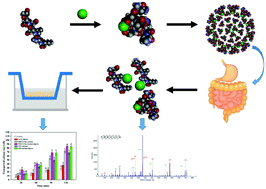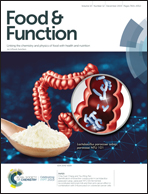The formation mechanism of a sea cucumber ovum derived heptapeptide–calcium nanocomposite and its digestion/absorption behavior
Abstract
Asn-Asp-Glu-Glu-Leu-Asn-Lys (NDEELNK), derived from a sea cucumber ovum, has shown a prominent calcium-binding ability. In this study, the formation mechanism of a NDEELNK–calcium nanocomposite and its digestion and absorption behavior were investigated. Results indicated that calcium ions specifically bound to two carboxyl oxygen atoms of Asp and Glu on the NDEELNK peptide in its monomeric form, and that the binding mode was referred to as the “bidentate” mode. Calcium coordination induced the self-assembly of the NDEELNK peptide dominated by an α-helix and a random coil structure, resulting in the formation of nanoparticles with a crystal structure. NDEELNK possessed a good digestive stability of 90.21 ± 1.11% in the gastrointestinal (GI) tract; moreover, two other fragments (DEELNK and EELNK) and seven modified variants were identified by nano-LC-ESI-MS/MS in the GI digests. Nevertheless, the GI digests of the NDEELNK–calcium complex could significantly enhance calcium absorption across the Caco-2 cell monolayers as compared to the initial complex.



 Please wait while we load your content...
Please wait while we load your content...